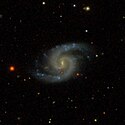IC 971
| Galaxie IC 971 | |
|---|---|
 | |
| SDSS-Aufnahme | |
| AladinLite | |
| Sternbild | Jungfrau |
| Position Äquinoktium: J2000.0, Epoche: J2000.0 | |
| Rektaszension | 14h 03m 52,8s[1] |
| Deklination | -10° 08′ 26″[1] |
| Erscheinungsbild | |
| Morphologischer Typ | SB(s)c[1][2] |
| Helligkeit (visuell) | 12,8 mag[2] |
| Helligkeit (B-Band) | 13,3 mag[2] |
| Winkelausdehnung | 2,3′ × 1,3′[2] |
| Positionswinkel | 126°[2] |
| Flächenhelligkeit | 13,8 mag/arcmin²[2] |
| Physikalische Daten | |
| Rotverschiebung | 0.011098 ± 0.000013[1] |
| Radialgeschwindigkeit | 3327 ± 4 km/s[1] |
| Hubbledistanz vrad / H0 | (146 ± 10) · 106 Lj (44,7 ± 3,1) Mpc [1] |
| Geschichte | |
| Entdeckung | Truman H. Safford |
| Entdeckungsdatum | 20. Mai 1868 |
| Katalogbezeichnungen | |
| IC 971 • PGC 50120 • MCG -02-36-005 • IRAS 14012-0954 • 2MASX J14035278-1008260 • GALEXASC J140352.83-100824.7 | |
IC 971 ist eine Balken-Spiralgalaxie vom Hubble-Typ SBc im Sternbild Jungfrau auf der Ekliptik. Sie ist rund 146 Millionen Lichtjahre von der Milchstraße entfernt und hat einen Durchmesser von etwa 100.000 Lichtjahren. Wahrscheinlich bildet sie gemeinsam mit IC 4358 ein gravitativ gebundenes Galaxienpaar.
Im selben Himmelsareal befinden sich u. a. die Galaxien NGC 5442, IC 4361, IC 4364, IC 4368.
Das Objekt wurde am 20. Mai 1868 vom französischen Astronomen Truman Henry Safford entdeckt.[3]
Siehe auch
Weblinks
Einzelnachweise
Auf dieser Seite verwendete Medien
Autor/Urheber: Sloan Digital Sky Survey, Lizenz: CC BY 4.0

Angle of view: 4' × 4' (0.3" per pixel), north is up.
Details on the image processing pipeline: https://www.sdss.org/dr14/imaging/jpg-images-on-skyserver/


